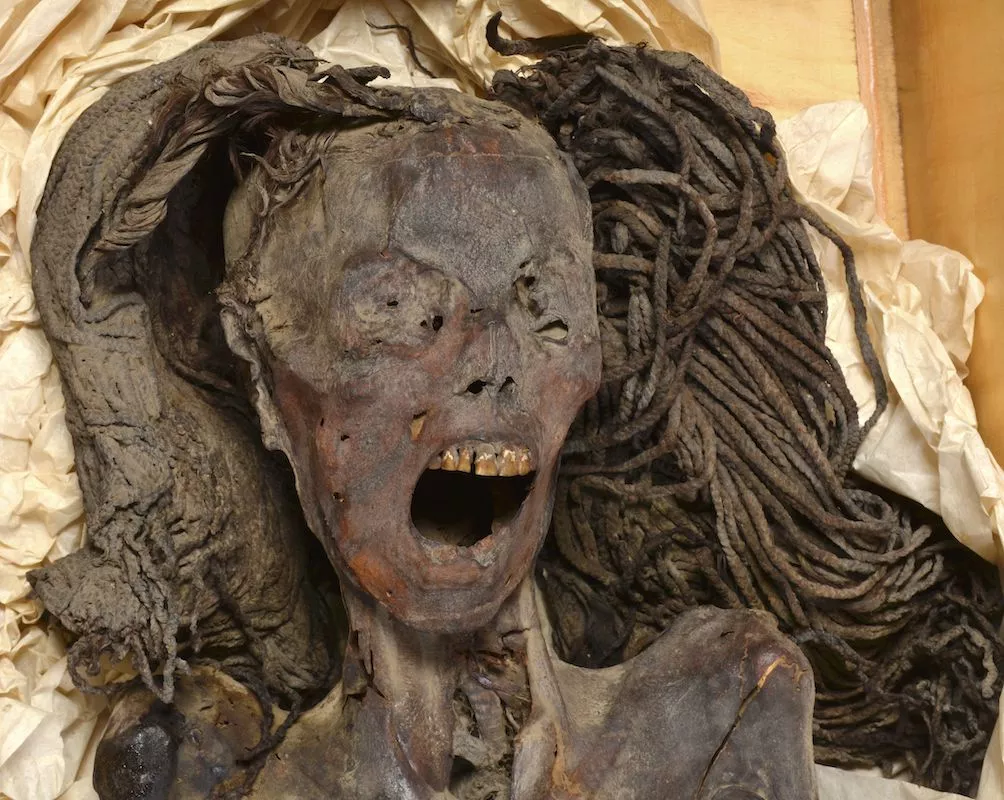New insights into a mummy frozen in time with mouth agape, which has both disturbed and fascinated archeologists for decades, have revealed that her animated expression was not due to a shoddy embalming job as earlier believed but more likely caused by dying in immense pain. But we still don't know what happened in her last minutes.
The mummified figure known as the 'Screaming Woman' was discovered near Luxor, Egypt in 1935, beneath the tomb of Senmut in a burial chamber set aside for his family members. Found in a wooden coffin, the elderly woman dressed in a black wig and gold and silver scarab rings had been mummified with nothing short of a look of horror on her face. This was originally believed to be an oversight by the embalmers, who neglected to close her mouth and preserve her body in a more 'peaceful' pose.

Now, Cairo University researchers have used cutting-edge technology to "virtually dissect" the woman, and it's revealed that the way she was prepared for her burial suggest there's far more to her 3,500-year-old story than previously thought.
"Here we show that she was embalmed with costly, imported embalming material," said Dr Sahar Saleem, a professor of radiology at Kasr Al Ainy Hospital at Cairo University. "This, and the mummy's well-preserved appearance, contradicts the traditional belief that a failure to remove her inner organs implied poor mummification."
The woman had been buried with all of her organs intact, which was hugely unusual for mummification at the time in the New Kingdom (1550–1069 BCE), where bodies had all their organs besides the heart removed. Here, the woman's brain, diaphragm, heart, lungs, liver, spleen, kidneys and intestine were still intact, with the researchers finding no evidence of embalming incisions that would have indicated their removal.
“The Screaming Woman is a true ‘time capsule’ of the way that she died and was mummified,” said Saleem.
Saleem and study co-auther Dr Samia El-Merghani used scanning electron microscopy (SEM), Fourier transform infrared spectroscopy (FTIR), and X-ray diffraction analysis (XRD) to "virtually dissect" the remarkably intact body and materials the woman had been buried with, in order to get a read on her condition and age at the time of death.

The 2D and 3D CT scans revealed that the woman had been 1.54 m (5-ft) tall, and pelvic bone joint morphology indicated to the scientists that she was around 48 years old when she died. Bone spurs (osteophytes) along her vertebrae also revealed that she suffered from mild spinal arthritis.
A skin FTIR analysis found that she'd had her body prepared with juniper and frankincense – two expensive imports that at the time would have been sourced from the Eastern Mediterranean and East Africa or Southern Arabia. The wig she was buried in was made from date palm fibers treated with quartz, magnetite and albite crystals. The scientists believe this process was to give the wig stiffness and a black hue, a representation of youth at the time in Egypt. Beneath it, her natural hair had also been treated with care, dyed with henna and juniper.
“These findings support the ancient trade of embalming materials in ancient Egypt," said Saleem. "The expedition led by Queen Hatshepsut brought frankincense from Punt (possibly Somalia in Africa). The tomb of Tutankhamun also contained frankincense and juniper."
Bone resorption in the woman's jaw suggested she'd lost several teeth before her death, while others had been broken or were likely in poor condition at the end of her days. But those lost teeth may have been a result of early dental procedures.
“Teeth lost during life may have been extracted," said Saleem. "Dentistry had originated in ancient Egypt, with Hesy Re the first recorded physician and dentist in the world."
However, one question remains unanswered: What caused the Screaming Woman to be mummified with such an agonizing expression on her face? The researchers can't be sure – except that she most likely died in pain, contrary to long-held beliefs that it was due to lazy burial procedures. And they hypothesize that it could have been due to cadaveric spasm.
“The mummy's screaming facial expression in this study could be read as a cadaveric spasm, implying that the woman died screaming from agony or pain,” said Saleem.
Cadaveric spasm, or postmortem spasm, occurs when a group of muscles that were engaged right before death become stiff and rigid. The condition is often the evidence of violent, physical and deeply emotional deaths.
"The widely opened mouth could be a result of a facial expression of suffering before death, fixed by cadaveric spasm," the researchers concluded. "The study also explores how rigor mortis, cadaveric spasms, tissue decomposition, burial techniques, and postmortem alterations may contribute to a mummy's screaming appearance."
The study was published in the journal Frontiers in Medicine.
Source: Cairo University via Scimex







